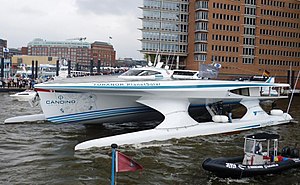Tûranor PlanetSolar
 Tûranor PlanetSolar in Hamburg
| |
| History | |
|---|---|
| Name | MS Tûranor PlanetSolar |
| Owner | PlanetSolar SA |
| Builder | Knierim Yachtbau, Kiel, Germany |
| Cost | €15 million |
| Launched | 31 March 2010 |
| General characteristics [1] | |
| Class and type | Yacht |
| Displacement | 85 metric tons |
| Length | 31 m (35 m with flaps) |
| Beam | 15 m (23m with flaps) |
| Propulsion |
|
| Speed |
|
| Crew | 4 |
MS Tûranor PlanetSolar, known under the project name PlanetSolar, is the largest solar-powered boat in the world[2] The vessel was designed by LOMOcean Design, built by Knierim Yachtbau in Kiel, Germany,[3][4] and launched on 31 March 2010.
In May 2012, it became the first solar electric vehicle ever to circumnavigate the globe.[5]
Technical characteristics
The 31-meter boat is covered by 537 square meters[6] of solar panels rated at 93 kW,[7] which in turn connect to one of the two electric motors in each hull.[2] There are 8.5 tons of lithium-ion batteries in the ship's two hulls.[8] The boat's shape allows it to reach speeds of up to 14 knots.[1] The hull was model tested in wind tunnels and was tank tested to determine its hydrodynamics and aerodynamics. The boat was designed to be used as a luxury yacht after the record attempt was finished.[9]
It is currently being used as a floating marine research laboratory by Geneva University.

The boat is registered in Switzerland and was financed by a German entrepreneur. Construction cost was € 12.5 million.[10] The name Tûranor, derived from J.R.R. Tolkien's novel The Lord of the Rings, translates to "The Power of the Sun".[11]
Around the world
On 27 September 2010, Tûranor PlanetSolar set off from Monaco to circumnavigate the globe solely with the aid of solar power. One aim of the project was to focus public awareness on the importance of renewable energies for environmental protection.
The boat had a crew of six. The captain of the expedition was Frenchman Patrick Marchesseau, but at the midpoint of the circumnavigation (in New Caledonia in mid-May 2011) the French Canadian Erwann Le Rouzic took over as captain, to share the master's responsibility with Captain Marchesseau. Other participants were Christian Ochsenbein (Bern, Switzerland) and Jens Langwasser (Kiel, Germany); as well as the project initiator, president and expedition leader Raphaël Domjan (Neuchatel, Switzerland).
A significant stopover was Cancún, Mexico, during the 2010 United Nations Climate Change Conference held there from 29 November to 10 December 2010. During the expedition, Tûranor PlanetSolar broke two records: the fastest crossing of the Atlantic Ocean by solar boat and the longest distance ever covered by a solar electric vehicle. Technical problems with the propeller system forced the vessel to stay in an Asian port for two weeks of maintenance. Tûranor PlanetSolar returned to Monaco on 4 May 2012 after 584 days sailing around the globe. The vessel was then scheduled for a refit so it could be chartered to tourists in the Mediterranean Sea. Cruises are planned with 12 passengers and four crew on board.[5]
2013 voyage and transatlantic record
After an engine refit, Tûranor PlanetSolar broke its own record, crossing the Atlantic ocean from Las Palmas to Saint Martin in the Caribbean in only 22 days, four days faster than on the circumnavigation trip. The boat left Las Palmas on April 25 and arrived in Marigot on Saint Martin on May 18. The trip led to Miami, Florida, and then continued as a scientific expedition along the Gulf Stream.[12] On the return trip the boat reached St John's, Newfoundland, 1 August 2013 before heading back across the Atlantic.[13]
See also
- Cruise ship
- Solar Impulse, a solar powered airplane
- Earthrace, Bio Diesel powered LOMOcean design
- Solar vehicle
- List of circumnavigations
- List of solar-powered boats
References
- ^ a b "Technical Data Sheet". PlanetSolar.
- ^ a b Pilato, Fabrizio (February 26, 2010). "PlanetSolar 100′ catamaran has 38,000 photovaltaic solar cells, set to sail in March". Mobile Magazine.
- ^ "Tûranor PlanetSolar". Knierim Yachtbau.
- ^ "The solar boat PlanetSolar is launched during ceremony in Kiel". Reuters.
- ^ a b Gieffers, Hanna (4 May 2012). "Ankunft in Monaco: Solarboot schafft Weltumrundung in 584 Tagen". Spiegel Online (in German). Retrieved 5 May 2012.
- ^ "First Circumnavigation by Solar-Powered Boat". Guinness Records.
- ^ "PlanetSolar Unveils World's Largest Solar Boat". Environment News Service. February 27, 2010.
- ^ "An inside look at the world's largest solar-powered boat". The Verge. June 22, 2013.
- ^ "PlanetSolar". LOMOcean Design. Retrieved 2010-04-24.
- ^ Behling, Frank (24 April 2010). "Das Solarschiff fährt" (in German). Kieler Nachrichten.
- ^ "A Milestone in the Progress of Solar Mobility". PlanetSolar.
- ^ "PlanetSolar - four days faster across the Atlantic". Sail World. 19 May 2013. Retrieved 19 May 2013.
- ^ http://www.thetelegram.com/News/Local/2013-08-02/article-3336478/Solar-ship-visits-St.-Johns/1
External links
- planetsolar.org
- lomocean.com
- Virtual Tour of the PlanetSolar in Egypt (360TOURIST Egypt)
